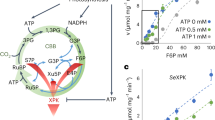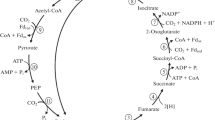Abstract
The Calvin cycle of carbon dioxide fixation constitutes a biosynthetic pathway for the generation of (multi-carbon) intermediates of central metabolism from the one-carbon compound carbon dioxide. The product of this cycle can be used as a precursor for the synthesis of all components of cell material. Autotrophic carbon dioxide fixation is energetically expensive and it is therefore not surprising that in the various groups of autotrophic bacteria the operation of the cycle is under strict metabolic control. Synthesis of phosphoribulokinase and ribulose-1,5-bisphosphate carboxylase, the two enzymes specifically involved in the Calvin cycle, is regulated via end-product repression. In this control phosphoenolpyruvate most likely has an alarmone function. Studies of the enzymes isolated from various sources have indicated that phosphoribulokinase is the target enzyme for the control of the rate of carbon dioxide fixation via the Calvin cycle through modulation of existing enzyme activity. In general, this enzyme is strongly activated by NADH, whereas AMP and phosphoenol-pyruvate are effective inhibitors. Recent studies of phosphoribulokinase inAlcaligenes eutrophus suggest that this enzyme may also be regulated via covalent modification.
Similar content being viewed by others
References
Andersen, K. 1979. Mutations altering the catalytic activity of a plant-type ribulose bisphosphate carboxylase/oxygenase inAlcaligenes eutrophus. — Biochim. Biophys. Acta585: 1–11.
Beudeker, R. F. 1981. Obligate chemolithotrophy: its ecophysiological implications forThiobacillus neapolitanus. — Ph. D. Thesis, University of Groningen.
Beudeker, R. F., Cannon, G. C., Kuenen, J. G. andShively, J. M. 1980. Relations betweend-ribulose-1,5-bisphosphate carboxylase, carboxysomes and CO2 fixing capacity in the obligate chemolithotrophThiobacillus neapolitanus grown under different limitations in the chemostat. — Arch. Microbiol.124: 185–189.
Bowien, L. andLeadbeater, L. 1984. Molecular and cellular regulation of carbon dioxide assimilation in bacteria. p. 9–13.In R. L. Crawford and R. S. Hanson (eds), Microbial Growth on C1 Compounds. — American Society for Microbiology, Washington, D.C.
Calvin, M. 1962. The path of carbon in photosynthesis. — Science135: 879–889.
Cohen, Y., De Jonge, I. andKuenen, J. G. 1979. Excretion of glycolate byThiobacillus neapolitanus grown in continuous culture. — Arch. Microbiol.122: 189–194.
Curtis, S. E. andHaselkorn, R. 1983. Isolation and sequence of the gene for the large subunit of ribulose-1,5-bisphosphate carboxylase from the cyanobacteriumAnabaena 7120. — Proc. Natl Acad. Sci. USA80: 1835–1839.
Dijkhuizen, L. 1979. Regulation of autotrophic and heterotrophic metabolism inPseudomonas oxalaticus OX1. — Ph. D. Thesis, University of Groningen.
Dijkhuizen, L. andHarder, W. 1979a. Regulation of autotrophic and heterotrophic metabolism inPseudomonas oxalaticus OX1: growth on mixtures of acetate and formate in continuous culture. — Arch. Microbiol.123: 47–53.
Dijkhuizen, L. andHarder, W. 1979b. Regulation of autotrophic and heterotrophic metabolism inPseudomonas oxalaticus OX1: growth on mixtures of oxalate and formate in continuous culture. — Arch. Microbiol.123: 55–63.
Dijkhuizen, L. andHarder, W. 1984. Regulation of autotrophic and heterotrophic metabolism inPseudomonas oxalaticus OX1. Growth on fructose and on mixtures of fructose and formate in batch and continuous cultures. — J. Gen. Microbiol.130: 447–457.
Dijkhuizen, L. andHarder, W. 1985. Microbial metabolism of carbon dioxide.In H. Dalton (ed.), Comprehensive Biotechnology, Vol. 1, The Principles of Biotechnology. — Pergamon Press Ltd, Oxford (in press).
Dijkhuizen, L., Knight, M. andHarder W. 1978. Metabolic regulation inPseudomonas oxalaticus OX1. Autotrophic and heterotrophic growth on mixed substrates. — Arch. Microbiol.116: 77–83.
Ellis, R. J. 1979. The most abundant protein in the world. — Trends Biochem. Sci.4: 241–244.
Evans, M. C. W., Buchanan, B. B. andArnon, D. I. 1966. A new ferredoxin-dependent carbon reduction cycle in a photosynthetic bacterium. — Proc. Natl Acad. Sci. USA55: 928–934.
Flügge, U. I., Stitt, M., Freisl, M. andHeldt, H. W. 1982. On the participation of phosphoribulokinase in the light regulation of CO2 fixation. — Plant Physiol.69: 263–267.
Friedrich, C. G. 1982. Derepression of hydrogenase during limitation of electron donors and derepression of ribulosebisphosphate carboxylase during carbon limitation ofAlcaligenes eutrophus. — J. Bacteriol.149: 203–210.
Friedrich, C. G., Friedrich, B. andBowien, B. 1981. Formation of enzymes of autotrophic metabolism during heterotrophic growth ofAlcaligenes eutrophus. — J. Gen. Microbiol.122: 69–78.
Fuchs, G. andStupperich, E. 1984. CO2 reduction to cell carbon in methanogens. p. 199–202.In R. L. Crawford and R. S. Hanson (eds), Microbial Growth on C1 Compounds. — American Society for Microbiology, Washington, D. C.
Gibson, J. L. andTabita, F. R. 1977. Different molecular forms ofd-ribulose-1,5-bisphosphate carboxylase fromRhodopseudomonas sphaeroides. — J. Biol. Chem.252: 943–949.
Gibson, J. L. andTabita, F. R. 1979. Activation of ribulose 1,5-bisphosphate carboxylase fromRhodopseudomonas sphaeroides: probable role of the small subunit. — J. Bacteriol.140: 1023–1027.
Gottschal, J. C. andKuenen, J. G. 1980. Mixotrophic growth ofThiobacillus A2 on acetate and thiosulfate as growth limiting substrates in the chemostat. — Arch. Microbiol.126: 33–42.
Hart, B. A. andGibson, J. 1971. Ribulose-5-phosphate kinase fromChromatium sp. strain D. — Arch. Biochem. Biophys.144: 308–321.
Herbert, D., Elsworth, R. andTelling, R. C. 1956. The continuous culture of bacteria; a theoretical and experimental study. — J. Gen. Microbiol.14: 601–622.
Im, D.-S. andFriedrich, C. G. 1983. Fluoride, hydrogen, and formate activate ribulosebisphosphate carboxylase formation inAlcaligenes eutrophus. — J. Bacteriol.154: 803–808.
Karagouni, A. D. andSlater, J. H. 1979. Enzymes of the Calvin cycle and intermediary metabolism in the cyanobacteriumAnacystis nidulans grown in chemostat cultures. — J. Gen. Microbiol.115: 369–376.
Kiesow, L. A., Lindsley, B. F. andBless, J. W. 1977. Phosphoribulokinase fromNitrobacter winogradskyi: activation by reduced nicotinamide adenine dinucleotide and inhibition by pyridoxal phosphate. — J. Bacteriol.130: 20–25.
Kuenen, J. G. andVeldkamp, H. 1973. Effects of organic compounds on growth of chemostat cultures ofThiomicrospira pelophila, Thiobacillus thioparus andThiobacillus neapolitanus. — Arch. Mikrobiol.94: 173–190.
Leadbeater, L. andBowien, B. 1984. Control of autotrophic carbon assimilation inAlcaligenes eutrophus by inactivation and reactivation of phosphoribulokinase. — J. Bacteriol.157: 95–99.
Leadbeater, L., Siebert, K., Schobert, P. andBowien, B. 1982. Relationship between activities and protein levels of ribulosebisphosphate carboxylase and phosphoribulokinase inAlcaligenes eutrophus. — FEMS Microbiol. Lett.14: 263–266.
Lorimer, G. H., Badger, M. R. andAndrews, T. J. 1976. The activation of ribulose-1,5-bisphosphate carboxylase by carbon dioxide and magnesium ions. Equilibria, kinetics, a suggested mechanism, and physiological implications. — Biochemistry15: 529–536.
MacElroy, R. D., Johnson, E. J. andJohnson, M. K. 1969. Control of ATP-dependent CO2 fixation in extracts ofHydrogenomonas facilis: NADH regulation of phosphoribulokinase. — Arch. Biochem. Biophys.131: 272–275.
MacElroy, R. D., Mack, H. M. andJohnson, E. J. 1972. Properties of phosphoribulokinase fromThiobacillus neapolitanus. — J. Bacteriol.112: 532–538.
Marsden, W. J. N. andCodd, G. A. 1984. Purification and molecular and catalytic properties of phosphoribulokinase from the cyanobacteriumChlorogloeopsis fritschii. — J. Gen. Microbiol.130: 999–1006.
McFadden, B. A. andTabita, F. R. 1974.d-Ribulose-1,5-diphosphate carboxylase and the evolution of autotrophy. — Biosystems6: 93–112.
Miziorko, H. M. andLorimer, G. H. 1983. Ribulose-1,5-bisphosphate carboxylase-oxygenase. — Annu. Rev. Biochem.52: 507–535.
Ogren, W. L. 1984. Photorespiration: pathways, regulation, and modification. — Annu. Rev. Plant Physiol.35: 415–442.
Ohmann, E. 1979. Autotrophic carbon dioxide assimilation in prokaryotic microorganisms. p. 54–67.In A. Pirson and M. H. Zimmermann (eds), Encyclopedia of Plant Physiology, Vol. 6, Photosynthesis II. — Springer Verlag, Berlin.
Reutz, I., Schobert, P. andBowien, B. 1982. Effect of phosphoglycerate mutase deficiency on heterotrophic and autotrophic carbon metabolism ofAlcaligenes eutrophus. — J. Bacteriol.151: 8–14.
Rittenberg, S. C. 1969. The roles of exogenous organic matter in the physiology of chemolithotrophic bacteria. — Adv. Microb. Physiol.3: 159–196.
Sani, A., De Koning, W., Dijkhuizen, L. andDow, C. S. 1983. Studies on the ribulose-1,5-bisphosphate carboxylase from the Rhodospirillaceae. — Proc. 4th Int. Symp. Microbial Growth on C1 Compounds, Minneapolis, U.S.A., p. 312.
Sarles, L. S. andTabita, F. R. 1983. Derepression of the synthesis ofd-ribulose 1,5-bisphosphate carboxylase/oxygenase fromRhodospirillum rubrum. — J. Bacteriol.153: 458–464.
Shinozaki, K., Yamada, C., Takahata, N. andSugiura, M. 1983. Molecular cloning and sequence analysis of the cyanobacterial gene for the large subunit of ribulose-1,5-bisphosphate carboxylase/oxygenase. — Proc. Natl Acad. Sci. USA80: 4050–4054.
Siebert, K., Schobert, P. andBowien, B. 1981. Purification, some catalytic and molecular properties of phosphoribulokinase fromAlcaligenes eutrophus. — Biochim. Biophys. Acta658: 35–44.
Slater, J. H. andMorris, I. 1973. Photosynthetic carbon dioxide assimilation byRhodospirillum rubrum. — Arch. Mikrobiol.88: 213–223.
Smith, A. J. andHoare, D. S. 1977. Specialist phototrophs, lithotrophs, and methylotrophs: a unity among a diversity of procaryotes? — Bacteriol. Rev.41: 419–448.
Somerville, C. R. andSomerville, S. C. 1984. Cloning and expression of theRhodospirillum rubrum ribulosebisphosphate carboxylase gene inE. coli. — Mol. Gen. Genet.193: 214–219.
Srivastava, S., Urban, M. andFriedrich, B. 1982. Mutagenesis ofAlcaligenes eutrophus by insertion of the drug-resistance transposon Tn5. — Arch. Microbiol.131: 203–207.
Storrø, I. andMcFadden, B. A. 1981. Glycolate excretion byRhodospirillum rubrum. — Arch. Microbiol.129: 317–320.
Tabita, F. R. 1980. Pyridine nucleotide control and subunit structure of phosphoribulokinase from photosynthetic bacteria. — J. Bacteriol.143: 1275–1280.
Tabita, F. R. 1981. Molecular regulation of carbon dioxide assimilation in autotrophic microorganisms. p. 70–82.In H. Dalton (ed.), Microbial Growth on C1 Compounds. — Heyden and Son, London.
Tabita, F. R., Martin, M. N., Beudeker, R. F., Quivey Jr, R. G., Sarles, L. S. andWeaver, K. E. 1984. Control of carbon dioxide fixation. p. 3–8.In R. L. Crawford and R. S. Hanson (eds), Microbial Growth on C1 Compounds. — American Society for Microbiology, Washington, D.C.
Tabita, F. R. andMcFadden, B. A. 1974.d-Ribulose 1,5-diphosphate carboxylase fromRhodospirillum rubrum. II. Quaternary structure, composition, catalytic, and immunological properties. — J. Biol. Chem.249: 3459–3464.
Tabita, F. R., Sarles, L. S., Quivey Jr, R. G., Weaver, K. E. andWaddill, F. E. 1983. Molecular regulation, mechanism and enzymology of autotrophic carbon dioxide fixation. p. 148–154.In D. Schlessinger (ed.), Microbiology-1983. — American Society for Microbiology, Washington, D. C.
Van Verseveld, H. W., Boon, J. P. andStouthamer, A. H. 1979. Growth yields and the efficiency of oxidative phosphorylation ofParacoccus denitrificans during two-(carbon) substrate-limited growth. — Arch. Microbiol.121: 213–223.
Weaver, K. E. andTabita, F. R. 1983. Isolation and partial characterization ofRhodopseudomonas sphaeroides mutants defective in the regulation of ribulose bisphosphate carboxylase/oxygenase. — J. Bacteriol.156: 507–515.
Whitman, W. B., Martin, M. N. andTabita, F. R. 1979. Activation and regulation of ribulose bisphosphate carboxylase-oxygenase in the absence of small subunits. — J. Biol. Chem.254: 10184–10189.
Wildner, G. F. 1981. Ribulose-1,5-bisphosphate carboxylase-oxygenase: aspects and prospects. — Physiol. Plant.52: 385–389.
Zeikus, J. G. 1983. Metabolism of one-carbon compounds by chemotrophic anaerobes. — Adv. Microb. Physiol.24: 215–299.
Author information
Authors and Affiliations
Rights and permissions
About this article
Cite this article
Dijkhuizen, L., Harder, W. Current views on the regulation of autotrophic carbon dioxide fixation via the Calvin cycle in bacteria. Antonie van Leeuwenhoek 50, 473–487 (1984). https://doi.org/10.1007/BF02386221
Issue Date:
DOI: https://doi.org/10.1007/BF02386221




